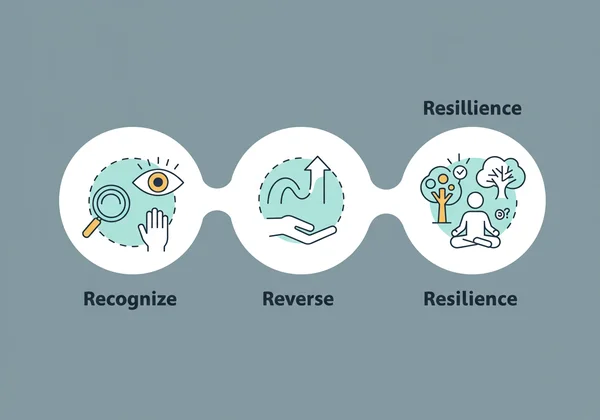How to Talk to Your Boss About Burnout: A Strategy Guide
Feeling the immense weight of burnout and dreading that conversation with your boss? You're not alone. Many professionals struggle with how to communicate their stress and exhaustion without jeopardizing their career. Knowing how to talk to your boss about burnout is a critical skill in today's demanding work environment. But what are the symptoms of your body shutting down from stress that you should identify first? This guide provides practical steps, conversation scripts, and powerful strategies to help you navigate this crucial discussion effectively and constructively. The first step towards a solution is understanding your own situation, which you can begin by taking a free burnout test.
Preparing to Tell Your Manager About Burnout
Before you schedule a meeting, thorough preparation is key. Walking into this conversation with clarity and confidence can make all the difference. This isn't about complaining; it's about advocating for your well-being and finding a sustainable path forward. By organizing your thoughts and evidence, you transform a potentially emotional chat into a productive, solution-focused discussion.
Recognizing Your Burnout Symptoms: The First Step
You can't articulate a problem you don't fully understand. Before discussing burnout with anyone, you must first recognize its signs within yourself. These often go beyond simple tiredness. Key burnout symptoms include persistent emotional exhaustion, a growing sense of cynicism or detachment from your job, and a feeling of reduced personal accomplishment. Do you feel drained before the workday even begins? Have you lost the passion you once had for your projects? Documenting these feelings is crucial. To get a clear, objective baseline, taking a scientific burnout test is a wise first step.

Choosing the Right Time and Place for a Sensitive Discussion
Timing is everything. Avoid ambushing your boss in a hallway or bringing it up at the end of a stressful team meeting. Request a private, one-on-one meeting specifically to discuss your workload and well-being. Schedule it for a low-stress time, like a Tuesday or Wednesday afternoon, when neither of you is rushing out the door or just starting the week. A calm, confidential setting allows for a more open and thoughtful conversation, showing that you respect both their time and the seriousness of the topic.
What to Prepare: Documenting Your Experience and Proposing Solutions
To make the conversation effective, you need more than just feelings—you need facts. Keep a simple log for a week or two, noting specific instances that contribute to your stress. This could include consistent long hours, an unmanageable number of projects, or a lack of resources. The goal is not to place blame but to provide concrete examples. More importantly, come prepared with potential solutions. This shows you are proactive and committed. Your proposals could include delegating certain tasks, adjusting deadlines, or exploring flexible work arrangements.

Navigating the Burnout Conversation with Your Boss
With your preparation complete, it's time to have the actual burnout conversation. Your approach should be calm, professional, and collaborative. Remember, the objective is to find a mutually beneficial solution that supports your mental health and maintains your productivity. Frame the discussion around your commitment to performing your best work and your need for adjustments to make that possible.
Opening the Dialogue: Practical Scripts and Conversation Starters
How you begin the conversation sets the tone for everything that follows. Avoid starting with negative or accusatory language. Instead, use professional and neutral conversation starters that open the door for a constructive dialogue.
Here are a few examples:
-
"Thank you for meeting with me. I'd like to talk about my current workload and find ways to ensure my long-term effectiveness on the team."
-
"I'm deeply committed to my role here, and recently, I've been feeling the effects of sustained high pressure. I'd love to partner with you on some strategies to manage this."
-
"I want to proactively discuss my capacity to ensure I can continue delivering high-quality work. Could we review my current projects and priorities?"

Communicating Your Needs and Setting Healthy Boundaries
Clearly articulating your needs is essential. Use "I" statements to express your feelings and experiences without sounding accusatory. For instance, instead of saying, "You're giving me too much work," try, "I am finding it challenging to meet all my deadlines with the current project load, which is impacting my well-being." When setting healthy boundaries, be specific. This could mean establishing a rule against checking emails after 7 PM or requesting uninterrupted focus time for deep work. Clearly defined boundaries are not a sign of weakness; they are a prerequisite for sustained high performance.
What If Your Boss Isn't Receptive? Handling Potential Pushback
While we hope for a supportive response, you should be prepared for potential pushback. Your boss might be stressed themselves or may not fully understand burnout. If you encounter resistance, try to remain calm and professional. Do not get defensive. Reiterate your points using the factual evidence you prepared. You can say, "I understand there are business pressures. My goal is to find a solution that prevents my exhaustion from affecting my work quality." If the conversation is unproductive, know when to pause. You can suggest revisiting the topic in a few days. If the situation doesn't improve, it may be time to consider other resources.
Maintaining Workplace Mental Health Post-Conversation
The conversation is not the end of the process; it's the beginning of a new phase. Actively maintaining workplace mental health requires ongoing effort from both you and your manager. Following up on your discussion and establishing a long-term plan is crucial for creating lasting change and preventing a relapse into burnout. This is about building a more sustainable and healthy relationship with your work.
Following Up: Documenting Agreements and Tracking Progress
After your meeting, send a brief follow-up email. This serves two purposes: it shows professionalism and creates a written record of what was discussed. Summarize the key points, the solutions you agreed upon, and any action items. For example: "Thanks for our chat today. Per our discussion, I will delegate X task to Jane, and we will check in next week to reassess my workload on the Y project." This ensures clarity and accountability for tracking progress on the agreed-upon changes.
![]()
When to Seek External Support: HR, EAP, or Mental Health Professionals
If your conversation with your boss doesn't lead to meaningful change, or if you feel unsupported, remember that you have other options. Your company's Human Resources (HR) department can provide mediation or clarify company policies on employee well-being. Many companies also offer an Employee Assistance Program (EAP), which provides confidential, free access to counseling and other support services. Don't hesitate to seek help from external support systems. A mental health professional can provide you with coping strategies and support that go beyond the workplace. Getting a clear picture of your situation through a Job Burnout Test can be a valuable document to share with these professionals.
Your Next Steps: Moving from Awareness to Action
Having a conversation about burnout with your boss is a courageous act of self-advocacy. By preparing thoroughly, communicating clearly, and following up proactively, you can turn a moment of vulnerability into a catalyst for positive change. It’s about reclaiming control over your professional life and building a more sustainable career path.
Understanding your burnout is crucial for effective action. Before you speak with your manager, consider taking a confidential, science-backed assessment. This will provide objective insights into your current risk, empowering you to take a clear first step towards recovery. Take our free burnout test today.
Frequently Asked Questions About Burnout and Your Boss
Should I tell my boss I am burnt out?
Yes, in most cases, it is beneficial to tell your boss, provided you feel psychologically safe to do so. Frame the conversation around your workload, well-being, and commitment to finding solutions, rather than simply stating "I'm burnt out." Having data from a tool like our free burnout test can help you articulate your experience more objectively.
Can you be fired for burnout?
Burnout itself is not a legally protected diagnosis in many places, so the answer is complex. However, you often cannot be fired for a medical condition that may result from or co-occur with burnout, such as anxiety or depression, as these can be protected under disability laws. It is always best to consult with your HR department or a legal expert to understand your rights in your specific location.
What are the three R's to coping with burnout?
The "Three R's" are a widely recognized framework for burnout recovery:
-
Recognize: Watch for the warning signs of burnout, such as exhaustion and cynicism.
-
Reverse: Actively seek support and manage stress to undo the damage.
-
Resilience: Build your resilience to stress by focusing on your physical and emotional health, including getting proper sleep, nutrition, and practicing self-care.

Who is at fault for burnout?
Burnout is rarely the fault of a single individual. It is most often a result of systemic issues within an organization—such as excessive workload, a toxic culture, lack of autonomy, or insufficient recognition. While individuals are responsible for their self-care, the organization is primarily responsible for creating a healthy work environment. Before pointing fingers, a great first step is to take an online burnout assessment to understand how these factors are affecting you personally.